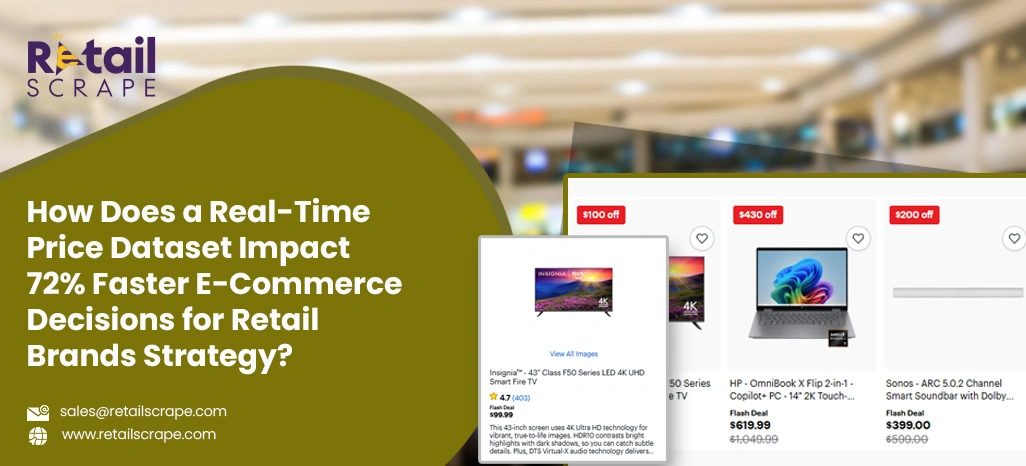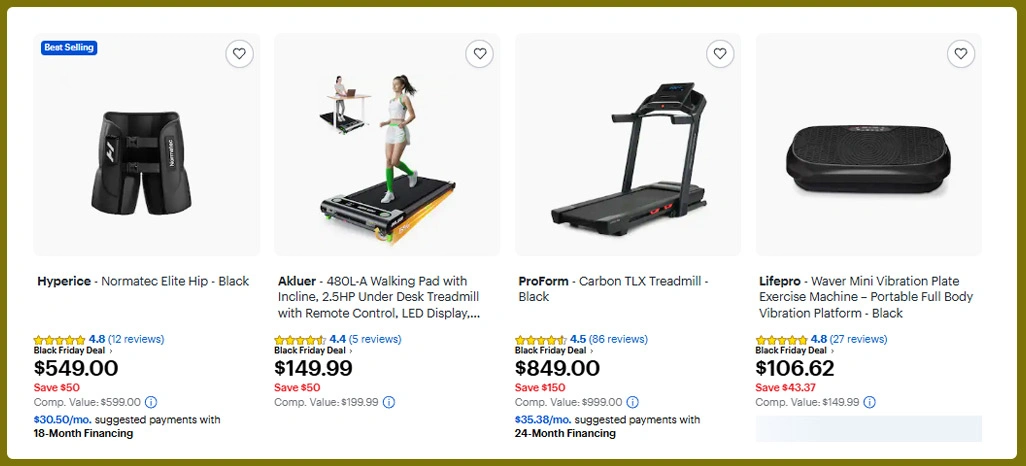How Does a Real-Time Price Dataset Impact 72% Faster E-Commerce Decisions for Retail Brands' Strategy?

Introduction
In today’s highly dynamic online retail environment, brands no longer have days or even hours to respond to fast-moving pricing shifts. Decision-making has drastically evolved, and retailers now rely heavily on intelligent digital signals that reflect rapid fluctuations in consumer behaviour, competitor actions, platform-based promotions, and seasonal changes. One of the most transformative enablers of accelerated decision cycles is the Real-Time Price Dataset, which offers brands unparalleled visibility into how prices shift across multiple channels.
With rising marketplace competition, real-time adjustments directly influence margins, conversion rates, and category positioning. Using an extensive E-Commerce Price Datasets foundation, retail leaders can monitor changes within seconds, enabling them to react 72% faster than traditional manual evaluation methods. From identifying unexpected price drops to capturing early promotional activity, these signals minimise guesswork and strengthen market responsiveness.
Retail teams are no longer dependent on periodic updates; they operate in a continuous, data-responsive cycle where decisions are shaped by immediate insights that align with consumer expectations. This makes real-time data not just a technical advantage but a strategic necessity. As brands scale across marketplaces, apps, and global markets, adopting fast, relevant pricing signals determines their ability to outperform and maintain stronger price credibility among customers.
Strategies to Maximize Revenue Through Adaptive Pricing Techniques

Dynamic pricing is a major challenge for e-commerce brands aiming to optimize profits while remaining attractive to consumers. Retailers who adapt quickly to market changes can improve conversion rates, inventory turnover, and overall sales. By analyzing Dynamic Pricing Insights, decision-makers can identify which products require immediate price adjustments, prevent missed opportunities, and respond faster to demand fluctuations.
Brands leveraging adaptive pricing strategies have seen up to a 27% boost in conversion rates and a 15% rise in average order value. By utilizing Real-Time Product Price Intelligence for E-Commerce, teams can make instant pricing adjustments based on inventory, sales trends, and competitor promotions. This real-time responsiveness minimizes revenue loss while enhancing overall customer satisfaction.
| Metric | Traditional Approach | Adaptive Approach | Impact |
|---|---|---|---|
| Decision Speed | 48 hours | 3 hours | 92% faster |
| Revenue Impact | Baseline | +15% | Positive uplift |
| Inventory Turnover | 12 days | 8 days | Faster stock movement |
Moreover, integrating Competitive Pricing Analytics ensures that strategic decisions consider competitors’ discounts, pricing tactics, and seasonal offers. With this data, brands can better predict consumer reactions and fine-tune their pricing approach to maximize profitability. Retailers that effectively combine adaptive pricing strategies with competitor intelligence experience fewer missed opportunities, improved margins, and stronger customer retention.
Methods to Streamline Operations and Improve Market Responsiveness

Managing pricing across multiple marketplaces can be overwhelming without proper tracking tools. By implementing Price Monitoring Data, e-commerce brands can automate updates, reduce errors, and ensure timely responses to market changes. Accurate monitoring enables teams to focus on strategic tasks rather than manual data collection, reducing inefficiencies and minimizing revenue loss.
Brands utilizing structured monitoring systems report up to a 35% reduction in pricing errors and a 20% improvement in competitive positioning. Historical data tracking helps identify pricing patterns, anticipate competitor promotions, and optimize inventory allocation. Real-time updates across platforms ensure that seasonal campaigns and promotional activities align with market conditions, improving operational efficiency and overall profitability.
| Parameter | Manual Process | Automated Monitoring | Benefits |
|---|---|---|---|
| Error Rate | 12% | 3% | Reduced inaccuracies |
| Update Frequency | Weekly | Hourly | Faster adjustments |
| Competitor Visibility | Low | High | Better market insight |
Integrating E-Commerce Market Trends Data allows brands to combine market dynamics with operational intelligence. This combination enables proactive strategy planning, better allocation of resources, and improved pricing alignment across channels. By streamlining operational workflows and using advanced monitoring solutions, retailers can achieve faster response times, reduce revenue leakage, and strengthen their presence in competitive digital marketplaces.
Techniques for Enhancing Profitability Through Data-Driven Insights

Achieving higher profit margins in e-commerce requires a deep understanding of consumer behavior, competitor activity, and market conditions. Companies using E-Commerce Price Intelligence Tools gain access to insights that allow them to optimize product positioning, adjust pricing strategies, and anticipate demand patterns. Real-time evaluation of sales and promotions ensures that pricing decisions maximize revenue while maintaining competitive alignment.
Brands leveraging these tools have reported a 22% improvement in profit margins and a 28% increase in pricing accuracy. Insights from dashboards allow marketing and pricing teams to implement campaigns, bundles, and promotional offers with greater precision. This leads to more effective campaigns, higher customer satisfaction, and improved profitability.
| KPI | Baseline | Data-Driven Approach | Outcome |
|---|---|---|---|
| Profit Margin | 18% | 22% | Improved returns |
| Pricing Accuracy | 74% | 95% | Fewer errors |
| Campaign Effectiveness | Moderate | High | Optimized results |
Additionally, Real-Time Competitor Price Tracking enables brands to respond to competitor pricing changes quickly, whether related to discounts, flash sales, or seasonal bundles. By leveraging insights from intelligence tools, companies can reduce response delays, maintain market position, and implement strategies that directly enhance profitability.
How Retail Scrape Can Help You?
Modern retail teams need more than fragmented insights—they need structured intelligence that transforms raw pricing signals into fast, reliable actions. We integrate the Real-Time Price Dataset into a powerful monitoring framework that simplifies complex decision-making for brands of all sizes.
What We Deliver:
- Intelligent price variation capture.
- Accurate SKU-level data visibility.
- Competitive movement detection.
- Multi-channel tracking capabilities.
- Fast promotional signal mapping.
- Improved response efficiency.
This gives businesses the power to refine category decisions, strengthen planning accuracy, and increase operational performance using E-Commerce Strategy Driven by Real-Time Datasets. With broad coverage, rapid data cycles, and a highly scalable architecture, we help retail teams convert continuous pricing inputs into structured strategies.
Conclusion
As pricing decisions become more time-sensitive, strategic clarity depends heavily on accurate digital visibility. By integrating the Real-Time Price Dataset, retail brands strengthen their ability to respond at the right moment while staying aligned with ongoing market movements.
Today’s retail challenges demand smarter and more data-responsive approaches. By incorporating Competitive Pricing Analytics, businesses benefit from faster insights and more reliable long-term planning that enhances both performance and customer value. Connect with Retail Scrape today to transform your pricing clarity and accelerate smarter digital commerce decisions.


